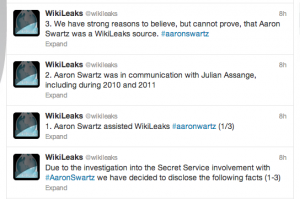Stephen Heymann Involved in Swartz Investigation before Arrest
Ryan Reilly reports that Aaron Swartz’s last attorney, Elliot Peters, filed an Office of Professional Responsibility complaint against Swartz prosecutor Stephen Heymann in January. The complaint covers three things:
- Delaying the disclosure of an email showing the Secret Service was involved in the investigation from the start and therefore should have gotten a warrant for Swartz’s computer before a month had elapsed
- Pressuring Swartz to plead guilty with threats of inflated prison time
- Delaying the disclosure of when Heymann first got involved in the prosecution and hiding other pertinent emails and reports
Reilly discusses the substance of the first item — which pertains to issues I covered in this post on Secret Service’s belatedly disclosed early involvement in the investigation and this post on the six week delay before actually searching Swartz’s computer.
Peters argued that the government failed by waiting more than a month to obtain the warrant. Heymann countered that he couldn’t get a warrant because he didn’t have access to the equipment. But an email in Heymann’s possession, which was written to Heymann himself, showed that assertion to be untrue.
In an email that was not provided to the defense team until the last minute, Michael Picket, a Secret Service agent, wrote to Heymann on Jan. 7, “I am prepared to take custody of the laptop anytime after it has been process for prints or whenever you feel is appropriate.
Reilly’s report (and the complaint) provide more substantiation for Peters’ claim that Heymann waited until after a status conference on whether or not the judge would hold a hearing on the suppression issues to hand over the email. The key complaint against Heymann, then, is that he didn’t turn over a key document until he knew the judge would actually investigate the issues around that document.
But I’m just more interested in the part of the complaint that is current hidden, the context of which is provided in the complaint.
Meanwhile, on December 21, 2012, AUSA Heymann produced yet another, much larger set of documents relevant to Mr. Swartz’s motion to suppress. This voluminous, disorganized production consisted of hundreds of previously-undisclosed emails, as well as hundreds of other documents, including undisclosed investigative reports, photographs, spreadsheets, and screen captures. Many of the newly-disclosed emails and reports further illustrated that the Secret Service was in control of investigating Mr. Swartz, and that AUSA Heymann was himself involved in the investigation even before Mr. Swartz was arrested on January 6, 2011. See, e.g.,
[paragraph-long redaction]
Upon review of the December 21 discovery, it became apparent to use that AUSA Heymann was well aware of the Secret Service’s investigation of Mr. Swartz’s case from its inception. This made AUSA Heymann’s misrepresentation about the Secret Service’s involvement in the seizure of Mr. Swartz’s electronic devices all the more troubling, because the misrepresentation could not have been made accidentally. Rather, because the December 21 documents had never before been disclosed to the defense, Mr. Swartz and his attorneys did not have the opportunity to consider and argue their relevance in Mr. Swartz’s motions to suppress, which had been filed months prior to disclosure.
While DOJ is clearly hiding the most interesting part of this, even this passage is telling. It reveals that:
- Heymann was involved before January 6
- DOJ withheld emails, documents, investigative reports, photographs, spreadsheets, and screen captures
- Heymann was aware of Secret Service’s investigation “from its inception”
The least damning potential issue here is that Heymann was brought into the investigation on January 4, along with the Cambridge police and Secret Service, and that the belatedly disclosed reports showed a great deal of Secret Service investigation that had not been turned over. Given the language used in the complaint and the fact that the Secret Service technically handcuffed Swartz, it also seems to suggest that Secret Service was not just brought into the investigation (as suggested by what we’ve seen so far), but what the lead from the very start.
But there are other far more interesting possibilities which, if true, would explain a lot of questions I’ve had about the investigation. Here are some possibilities — and note, these are just wildarsed guesses:
- Was Secret Service involved before MIT called the Cambridge police on January 4? Did they (or a contractor like Carnegie Mellon’s CERT team) provide the data flow reports that first identified the location of Swartz’s computer? Are those data flow reports included in the late discovery? Did Secret Service know the identity of Swartz before they conducted the flow, or before they caught him in the network closet?
- Did MIT call Secret Service before they called CPD? Did they call Secret Service before January 4, 2011? Did Secret Service call MIT first?
- Did the photos in the belated discovery include photos of Swartz used to stake out Swartz’s apartment the day he was arrested? Had they already been staking out his apartment?
- Peters has said DOJ subpoenaed Internet Archive for multiple versions of the Guerilla Open Access Manifesto. That seems to contradict what DOJ told the defense in earlier discovery motions. Were those subpoenaed reports part of the belated discovery?
Aside from these WAGs about what the hidden material might include, there are larger questions about whether they piggy backed an investigation into Swartz onto larger investigations of Cambridge hackers and/or other open access activists. Remember: past statements by the government left open the distinct possibility that they had emails “not relevant to this case.” I wonder whether those were among the emails turned over after DOJ learned the judge would hold a hearing into improprieties of the searches into Swartz.
Those are questions DOJ doesn’t want to answer.

